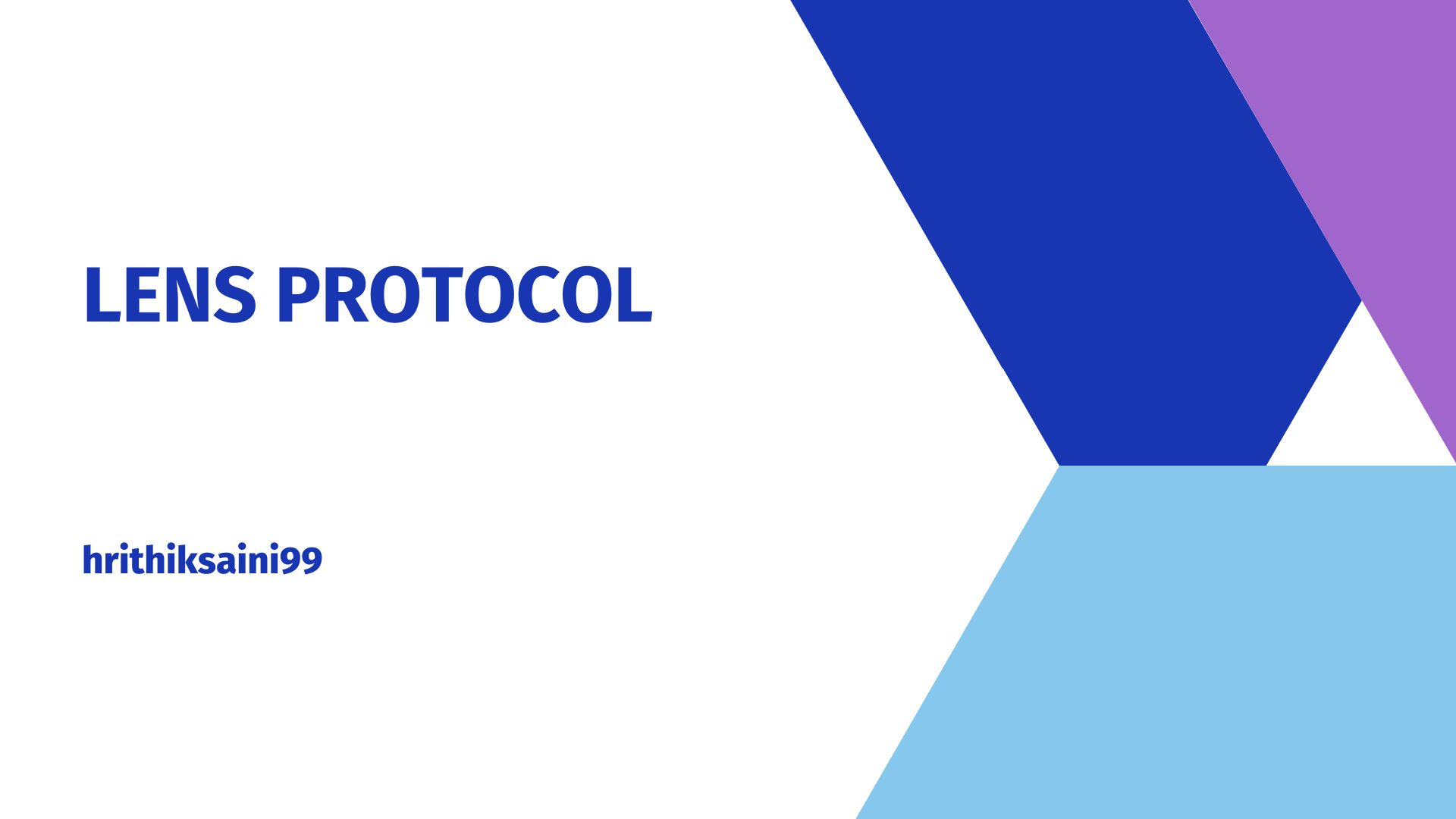What is LENS PROTOCOL?
 HRITHIK SAINI
HRITHIK SAINI
I. Introduction
Lens Protocol is a revolutionary new technology that allows developers to build social media platforms on the blockchain. It is a composable and decentralized social graph, meaning that it allows for the creation of a decentralized and interconnected network of social media platforms. This technology has the potential to change the way we think about and interact with social media.
The current state of social media is dominated by a few large tech companies that control the majority of the market share. These companies, such as Facebook, Twitter, and Instagram, have a significant amount of control over the content that is shared and seen on their platforms. They also take a large percentage of the revenue generated by creators on their platforms.
Lens Protocol aims to solve this problem by providing a new way for creators to monetize their content and for users to interact with social media. By building social media platforms on the blockchain, Lens Protocol allows for a decentralized and transparent system where creators are directly incentivized and users have more control over their data and interactions. This can lead to a more equitable and sustainable social media ecosystem.
II. The Problem with Web2.0 Social Media -
One of the main problems with the current state of social media often referred to as Web 2.0, is the issue of platforms taking a large percentage of creator revenue. For example, platforms like Meta take a 45% cut of the total revenue generated by creators on their platforms. This means that creators are often left with a small fraction of the revenue generated by their content. This can make it difficult for creators to earn a sustainable income from their work.
Another issue with Web 2.0 social media is the problem of content being locked in one place. When content is published on a social media platform, it is not automatically republished on other platforms. This means that creators have to manually republish their content on multiple platforms to reach a wider audience. This can take a significant amount of time and effort and can make it difficult for creators to grow their audience on multiple platforms.
Furthermore, the lack of interoperability between social media platforms creates a siloed experience for both the creators and the audience. It means that the creators have to rebuild their audience from scratch on every new platform, and it also means that the audience has to follow the creators on multiple platforms to keep up with their content, which results in a fragmented experience.
Overall, these issues make it difficult for creators to monetize their content and for users to have a seamless social media experience. Lens Protocol aims to solve these problems by providing a more decentralized and transparent system for social media.
III.How Lens Protocol Solves These Problems
Lens Protocol solves the problems of creator monetization and content being locked in one place through its decentralized and transparent system. By building social media platforms on the blockchain, Lens Protocol allows creators to monetize their content in new ways that are not possible on traditional Web 2.0 platforms.
One way creators can monetize their content on Lens Protocol-based platforms is through subscription fees. Creators can charge a fee for users to follow them on the platform, and this revenue goes straight to the creator without the need for intermediaries. This can provide a new revenue stream for creators and allow them to earn a sustainable income from their work.
Another way creators can monetize their content is through investments in their content. Followers can invest in the content created by their favorite creators. This can support creators to create more high-quality content for their followers and also, if possible, investors in the content can also get some cut from the revenue generated by the content.
Additionally, Lens Protocol-based platforms also allow creators to set certain restrictions on who can share and comment on their content. For example, creators can allow only followers or NFT holders to share/comment on their posts. This can increase the authenticity of the content and prevent spamming in the comments.
Another way that Lens Protocol solves the problem of content being locked in one place is through interoperability. Content shared on one platform built on Lens can also be visible on other platforms. This means that followers on one platform can know the creator's presence on another platform too and about their content on that platform. This can save creators time and effort in having to republish their content multiple times, and it can also make it easier for users to keep up with their favorite creators across various platforms.
In summary, Lens Protocol provides a new way for creators to monetize their content and for users to interact with social media. It allows for a decentralized and transparent system where creators are directly incentivized and users have more control over their data and interactions. This can lead to a more equitable and sustainable social media ecosystem.
IV. Examples of Platforms Built on Lens Protocol
Several social media platforms have been built on top of Lens Protocol, each utilizing the protocol's features in unique ways. Some examples of these platforms include:
Mirror: Mirror is a decentralized blogging platform built on Lens Protocol. It allows creators to monetize their content through subscription fees and investments in their content. Additionally, it also allows creators to set certain restrictions on who can share and comment on their content, which can increase the authenticity of the content and prevent spamming in the comments.
Sofa: Sofa is a decentralized social media platform built on Lens Protocol. It allows creators to monetize their content through subscription fees and investments in their content. It also allows creators to set certain restrictions on who can share and comment on their content. Additionally, Sofa also allows creators to share their content on other platforms, as well as follow their favorite creators across multiple platforms.
Cent: Cent is a decentralized social media platform built on Lens Protocol that focuses on allowing creators to monetize their content through cryptocurrency micropayments. It allows users to pay creators in small amounts for access to exclusive content, subscriptions, and other perks.
Rally: Rally is a decentralized social media platform built on Lens Protocol that focuses on community building. It allows creators to monetize their content through subscriptions, investments, and tips from followers. It also allows creators to set certain restrictions on who can share and comment on their content and share their content on other platforms.
Flote: A decentralized microblogging platform that allows users to post short-form content, images, and videos. Users can monetize their content through subscription fees, investments in their content, and tips from followers.
DTube: A decentralized video-sharing platform built on the Steem blockchain, DTube allows creators to monetize their content through cryptocurrency micropayments and investments in their content.
Peepeth: A decentralized social network that allows users to post short-form content, images, and videos. Users can monetize their content through subscription fees and investments in their content.
Minds: A decentralized social network that allows users to post content, images, and videos. It also allows users to monetize their content through cryptocurrency micropayments, subscriptions, and investments in their content.
Memo: A decentralized social network that allows users to post short-form content and images. Users can monetize their content through cryptocurrency micropayments and investments in their content.
BlockParty: a decentralized social media platform that allows users to create, join and attend events, as well as monetize their content through subscriptions, investments, and tips from followers.
These are just a few examples of social media platforms built on Lens Protocol, and as the technology continues to evolve, we can expect to see even more platforms utilizing the protocol's features in unique ways.
In summary, these platforms are utilizing the features of Lens Protocol such as: allowing creators to monetize their content through subscription fees, investments in content, and allowing only certain individuals to share/comment. They also allow creators to share their content on other platforms, as well as follow their favorite creators across multiple platforms, which is a great way to increase the creator's visibility and audience engagement.
V. Conclusion
In conclusion, Lens Protocol is a revolutionary new technology that allows developers to build social media platforms on the blockchain. It provides a new way for creators to monetize their content and for users to interact with social media. By building social media platforms on the blockchain, Lens Protocol allows for a decentralized and transparent system where creators are directly incentivized and users have more control over their data and interactions.
One of the main benefits of Lens Protocol for creators is the ability to monetize their content in new ways that are not possible on traditional Web 2.0 platforms. Through subscription fees, investments in content, and allowing only certain individuals to share and comment, creators can earn a sustainable income from their work. Additionally, the interoperability feature of Lens Protocol allows creators to share their content on other platforms, as well as follow their favorite creators across multiple platforms, which can save creators time and effort in having to republish their content multiple times.
The potential for Lens Protocol to change the social media landscape is significant. By providing a more decentralized and transparent system for social media, Lens Protocol has the potential to create a more equitable and sustainable social media ecosystem for creators and users alike. As more and more platforms are built on top of Lens Protocol, we can expect to see a shift in the way we think about and interact with social media. The future of social media looks very promising with the adoption of Lens Protocol.
Subscribe to my newsletter
Read articles from HRITHIK SAINI directly inside your inbox. Subscribe to the newsletter, and don't miss out.
Written by
